Random
Shots
- Officers of the 752nd -
Armored Training | Eboli to Rome | To the Arno | Northern ApenninesPo Valley | Vicenza Combat | Post-War | Officers | At Ease
 |
Lt. Col. Glen H. Anderson was the 752's first commander, serving from June 1941 to April 1942. Known as "Foghorn" for his deep, mellow voice, Lt. Col. Anderson was a West Point graduate who served as an infantry captain in WWI. He transferred to the 5th Armored Division, and was given command of its Combat Command Reserve (CCR). Under his command, CCR was awarded a Distinguished Unit Citation for action in the Hurtgen Forest. |
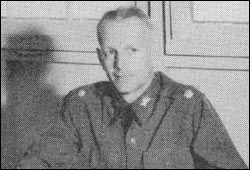 |
Major George Bender was the 752nd's Executive Officer at Ft. Lewis under Lt. Col Anderson. Bender was promoted to Lt. Col. and took command of the 752 in April 1942. His command continued until he was hospitalized with malaria in March 1943. Former officers describe Bender as "a fine soldier," and viewed his loss as regrettable. Bender was replaced by Lt. Col. Hyman Bruss, who had been relieved of his command of the 2nd Battalion, 13th Armored Regiment following "an appalling defeat" at Djebel bou Aoukaz on 6 December 1942. |
 |
The 752nd brass, Spring 1944. Left to right: Capt. Bill Darby, C Company Commander Capt. Henry Eitel, B Company Commander Capt. Kurt Stoehr, A Company Commander Major Coryton Woodbury, Executive Officer (later Bn Commander). Woodbury, known by his enemy as "The Iron Major," joined the 752nd in March 1943 as the battalion's Executive Officer under Bruss. |
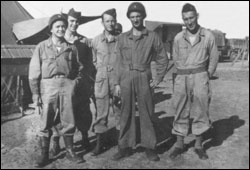 |
Officers of B Company, Spring 1944. Left to right: Capt. Henry Eitel, Lt. William McCoy, Lt. Dewey Ellard, Lt. Gayle Stockdale, and Lt. Richard Bonner. Eitel was badly wounded early in the war and left the unit. McCoy transferred to another unit in 1944. Ellard and Stockdale were both wounded, and soldiered through with the 752 to the end of the war. Bonner was captured but escaped a few hours later during an artillery barrage. |
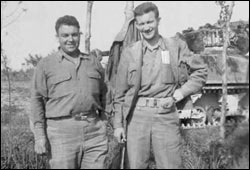 |
Lieutenant George Higley and Captain Gayle Stockdale of B Company, Spring 1945. Both officers were wounded in the heavy fighting in April 1945 shortly after this photo was taken. |
 |
Lieutenant Dewey Ellard, leader of B Company's 3rd Platoon. Lt. Ellard was badly wounded outside of Rome on 4 June 1944, but returned to the battalion in the Northern Apennines. Photo taken in early 1944. |
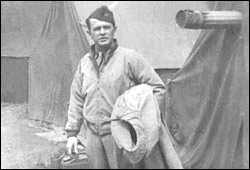 |
Captain Henry Eitel, commander of B Company, left the battalion after he was was badly wounded in July 1944. Photo taken in Spring 1944. |
 |
Captain Bill Darby, known as "Cap'n Beel" among the men, was Commander of C Company. Capt. Darby was badly wounded in July 1944, but returned to the battalion in the fall of 1944. Photo taken as a Lieutenant in late 1943. |
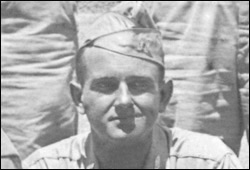 |
Captain Earl L. Wirt, Jr. commanded D Company (Light Tanks). As a 2nd Lt. in North Africa, Wirt was the S-2/S-3 Air. Wirt was promoted to Captain and served with the Armored Training School before D Company rejoined the rest of the battalion in combat operations. |
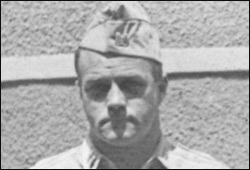 |
Command of the 752nd was passed to Major Cornelius J. McGroarty on 23 October 1945, after being very briefly commanded by Major Marvin H. Singley. McGroarty had previously served as a Captain/Executive Officer of the Armored Training School. McGroarty's command ran through 23 March 1946, at which time Major Urrutia assumed command. |
 |
Major Henry W. Urrutia, one of the 752nd's postwar commanding officers, at his desk on 8 November 1946. Major Urrutia had previously served with the 14th Armored Division in the ETO. Major Urrutia's command of the 752 ran until 12 March 1947, at which time he became the Executive Officer of the 1st Battalion of the 351st Infantry Regiment of the 88th Infantry Division. |
The sequence of command of the 752nd after Major Urrutia is a bit unclear. Records on file at the National Archives indicate that Major Urrutia was replaced on 12 March 1947 by Major Graham T. Stevens, but it appears that Major Stevens was reduced to Battalion Executive Officer two or three weeks later on 31 March 1947. At that time, it appears that a Lt. Col. Richardson took full command of the 752nd, as his name appears on various General Orders (though his appointment is not listed in any of the surviving 752nd General Orders). It is unclear what role Richardson played between this date and the deactivation of the 752nd, as the records show two "Acting Commander" appointments during this period. The first of these appointments was Captain Edward S. Robbins, whose Acting Commander status became effective 2 June 1947. The last command reference of the 752nd notes that Captain Gerald A. Harty became Acting Commander effective 9 July 1947, and it is assumed that he continued in this role until the 752nd's deactivation a month later on 10 August 1947. Lt. Col. Richardson's involvement with the 752nd during these months is unknown.
Researched and Written by Robert
J. Holt
Page Content Copyright 2003 - 2025 Robert J. Holt
All Rights Reserved